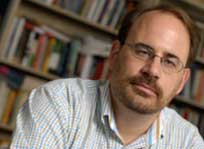
Steven Teles is an associate professor in the political science department at Johns Hopkins University. (Image: Johns Hopkins University.)
Forty years before the Roberts Supreme Court became a place where the Chamber of Commerce almost always wins, conservative donors made a significant, long-term investment in pushing the center of gravity in America’s legal culture toward the right.
In 2009, Steven Teles, a political scientist at Johns Hopkins University, literally wrote the book on that effort. In The Rise of the Conservative Legal Movement: The Battle for Control of the Law, Teles charted the early stumbles and later successes of a project that ultimately has yielded hefty returns to its backers.
In the wake of the court’s latest decision on behalf of America’s donor class, McCutcheon v. FEC, BillMoyers.com spoke with Teles about this history. Below is a transcript of our discussion that’s been edited for clarity.
Joshua Holland: The story you tell in this book really begins in the 1970s. There’s a well-funded effort to shift the ideological center of gravity in law schools, legal conferences and journals, and ultimately, in the courts themselves. How successful has that effort been?
Steven Teles: I think they were very successful in helping to reorient the political conversation. In today’s legal culture, conservative arguments aren’t exotic. People have heard of them. Liberals show up to Federalist Society events. The Federalist Society has always had a kind of evangelical quality. They always wanted to try, if not to persuade people, then at least make them think that their views were within the range of legitimate conversation. And I think in that sense they have been successful.
Over long periods of time it has shifted the range of ideas about what the courts can do. And I think in contrast, liberals have not been very good at that kind of investment. Liberals have been much more oriented towards short-term investments. They want metrics to show how things are paying off in two or three years. But if you really want to shift people’s ideas, that’s the work of decades, and that’s the kind of thing that a group of conservative foundations was willing to do.
When you see how aggressive this Supreme Court has often been, that’s partially because it’s staffed by clerks who’ve been to law schools like Harvard and Yale and Stanford, where they have strong Federalist Society chapters and they’ve gotten steeped in these ideas, and when they get onto the courts they provide these ideas to the justices. They’re helping write the decisions.
Liberals have not been good at that kind of work, and if they want to change some of these things, then they have to be willing to put their money into the same kind of really long-term investments.
Holland: What was it about our judiciary, or our judicial culture, that the right felt needed to be changed?
Teles: I think it’s important that we distinguish between the ‘judiciary’ and ‘judicial culture.’ In the book, I establish that conservatives were reacting as much to the law schools as to what was going on directly in the courts.
The story starts even earlier, back in the late ’50s and early ’60s when law school faculties became much more liberal, and started supporting legal rights of all kinds, and it’s that legal culture to which I think conservatives were reacting.
It’s also important to distinguish between what I think of as the elite reaction and the popular reaction. The popular reaction goes back to a series of church and state decisions that helped mobilize the Christian right. That’s an important part of the story.
And then what I write about in the book — things like the development of the Federalist Society, the law and economics movement and the rise of conservative public interest law — is really a reaction to this change in the elite legal culture. That’s an elite mobilization, and that’s what I write about in the book.
This mobilization didn’t come out of nowhere. The Ford Foundation and some other foundations had put enormous amounts of money into investing in legal clinics and public-interest law firms — a lot of the ones that we know and love today: the Environmental Defense Fund, National Resources Defense Council, the organizations of Hispanics and women in law.
So conservatives reacted by investing tens of millions of dollars to mobilize against these efforts. Lots of money was put into law and economics, which was an effort to try to get a foothold for free market economics in the law schools. The Federalist Society was created, which was an effort to create a kind of parallel curriculum in the law schools. Conservatives found it so hard to directly change the composition of the law schools, so their strategy was to bring their own faculty in to give talks and lectures to the students. And then there was an investment in public interest law firms on the right, like the Institute for Justice, Alliance for School Choice, and the Center for Individual Rights, which brought a lot of anti-affirmative action litigation. There was a broad attempt to mobilize against organized legal liberalism on all of these fronts.
Holland: Legal scholars and journalists covering the judiciary say that this Court is making decisions that would have been difficult to imagine not so long ago. There have also been a couple of studies that have found that conservative justices are more likely to overturn both acts of Congress and regulatory rules than their moderate and liberal counterparts.
That kind of judicial activism is in contrast to what a lot of people would think judicial conservatism means. One would think it would stress respect for past precedent and judicial restraint — conservatism. How do you reconcile that?
Teles: Well, first of all, conservatives were arguably very activist going back to the late 19th and early 20th centuries – that’s the Court we associate with the “Lochner Era.” And back then it was liberals who advocated judicial restraint. The whole New Deal was characterized by an argument for judicial restraint.
The era of conservatives preaching judicial restraint, starting in the ’60s and ’70s, began when they picked up liberal arguments at a time when liberals had started abandoning them. So it’s not surprising that in a period where liberals are starting to be activists, conservatives are arguing for judicial restraint. Then conservatives consolidate their power starting in the ’80s and ’90s, and they then start becoming activists in their use of the Courts.
So the political scientist in me thinks that this is a predictable feature of what ascendant political movements do – they generally are in favor of judicial activism as soon as they’ve consolidated their power over the Court.


